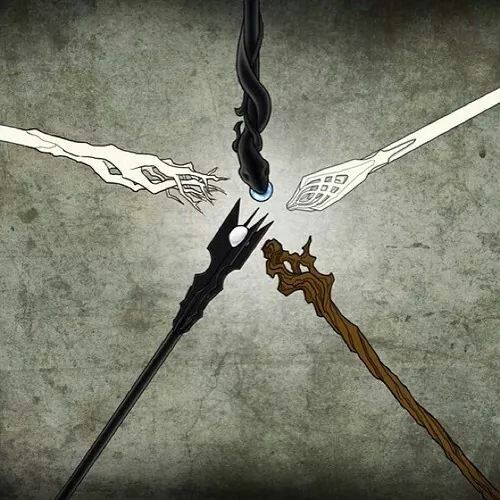Origins
Wizards, pointy hat and all, originated in some form long before Tolkien. Tolkien himself probably drew on old descriptions of the Norse god Odin, who unlike the modern Marvel rendition appeared most often in the ancient Nordic tales as a wandering old man. He was sometimes depicted with a staff, other times with a hat of sorts. Tolkien, who was steeped in the epics of the North countries, seems to have used some of those early descriptions as a starting point.
Of course, another famous wizard lived much closer to Tolkien, both in time and space, than the roving Odin. Tolkien had only to look to neighbouring Camelot for a more recognizably “English” wizard. Images of Merlin also fit part of the stereotypical wizard we think of today: old, bearded, sometimes hatted also. But there’s still nothing quite as distinctive as Tolkien’s own take.
Enter, Stage Left
It’s in The Hobbit where Tolkien gives us that wonderful, full-throated declaration of a wizard, one which almost no other author has been fully able to escape:
All that the unsuspecting Bilbo saw that morning was an old man with a staff. He had a tall pointed blue hat, a long grey cloak, a silver scarf over which his long white beard hung down below his waist, and immense black boots.
“Good morning!” said Bilbo, and he meant it. The sun was shining, and the grass was very green. But Gandalf looked at him from under long bushy eyebrows that stuck out further than the brim of his shady hat. (Tolkien, The Hobbit, p. 13)
The basics are here again – old man, beard, staff – but Tolkien added his own flourishes. For the first time, it’s a tall, pointy hat. There’s a scarf, which somewhat curiously has been overlooked by many imitators, but now stands forever immortalized by legions of Potter-ites the world over. Gandalf’s beard is almost stupidly long; in the hands of a poorer writer, this could have been borderline homeless-person territory. And yet, all the odd little elements in Gandalf’s description – the mismatched blue hat and grey cloak, the huge black boots – somehow amounted to of the greatest character introductions in all of literature.
For Gandalf is not, of course, a homeless beggar; he’s not even some sort of down-on-his-luck resident wise man. He’s wise, but he’s also immensely powerful. All the eccentricities of his outfit say, “This guy is something beyond the people you normally encounter.” More than the wizarding “uniform,” I think that’s the element that Tolkien plucked from the earlier tales of Odin and Merlin. Wizards are not magicians; they don’t specialize in tricks, magical or otherwise. Gandalf will even say so himself, famously, in the film edition of Fellowship of the Rings, when Bilbo initially refuses to give up the Ring. “I am not some conjurer of cheap tricks!” Gandalf declares angrily. In my opinion, it’s one of the better lines added in the movies, capturing some of Gandalf’s nature. Tolkien created Gandalf along the lines of Odin and Merlin – a man of immense power. Odin, remember, is a literal god, and one of the chief among the Norse mythology. Merlin is, well, Merlin; the only wizard possibly more famous and with a longer history than Gandalf himself. Like the other two, Gandalf will prove in Tolkien’s story to be a wielder of immense power. Like Merlin, he is also a key power broker behind the scenes, a chess master moving pieces into position across a huge board. And like Odin, he’s something greater than human.
For Gandalf is one of the Istari. “Oh, the Istari!” you say. “Uh, just refresh my memory again… what’s an Istari?” Well, I’m glad you asked. The Istari were Maiar, of course!
What’s in a Wizard?
If your eyes are starting to get a little crossed, don’t panic! The history of the Wizards (the Istari) starts to get perilously close to requiring a greater lesson on Tolkien’s whole mythology. That, of course, is a far bigger order than we can delve into here; if I ever decide to tackle that topic, we’ll put a link to it here for anyone wishing to dive in. It all boils down, roughly, to this: the Maiar were powerful spirits; not the “gods” or “chief angels” of Tolkien’s divine order, but their assistants. Think something along the lines of angels, or maybe archangels. There are countless Maiar, but a handful factor into the storylines of The Hobbit and The Lord of the Rings. By far the most significant of those is, um, the Lord of the Rings. That’s right, Sauron is a Maia. Unlike Gandalf, who arrives much later, Sauron becomes corrupted and falls into evil. His nature as a Maia is what lets him do some of his nastier tricks. In The Silmarillion, he can change form (he likes a bat-form, which is creepy), although he later appears as a handsome, winsome human male, leading the men of Numenor astray (the ones who escaped Sauron’s influence founded Gondor, so you can think of them as Aragorn’s super distant relatives.) Of course, in the Lord of the Rings, Sauron can’t take a physical form anymore. He’s permanently a spirit, appearing only as a great, fiery eye. There’s a whole string of events connecting those dots, but that’s the short version.
What’s this have to do with Gandalf? Like Sauron, Gandalf is a Maia. He’s an ancient spirit, who journeys, or rather is sent, from the Blessed Lands in the West, to Middle-Earth, to help combat the return of Sauron. And he’s not the only one; there are five wizards, although only three factor into the more well-known events. Each wizard took the shape of an old man, rather than, say, an Elf. I suspect (just a gut feeling here) that this is because Elves in Tolkien’s Faerie are the first creations of his gods; in some ways, they’re not terribly different from wizards. Elves live forever (unless they are killed) and are (usually) incredibly wise. Having an Elvish wizard may have somehow weakened the effect. So Tolkien sends the Wizards as men, older men to be precise. Unlike Sauron, they cannot change form; there also seems to me to be some sort of weakening effect, because they arrive in Middle-Earth later than Sauron does. Again, as an aside, Tolkien definitely shares one of the classic ideas of Faerie; in the youth of the world, magic was stronger, magical beings more common, etc. As the world ages, magic wanes, or perhaps withdraws; in Tolkien’s world, it seems to do both. The Elves withdraw and leave Middle-Earth, bit by bit. And while Gandalf and his fellow wizards are strong, even together they don’t seem to have the strength to take on Sauron, even when he’s in a weakened state, at least openly. (There’s one exception to this, but that’s a tale for another time. For those of you looking for a reference to Sauron as the Necromancer, though, I haven’t forgotten that part of the story!)
The Five Wizards
Five Maiar were sent into Middle-Earth, becoming the Wizards. They appeared as old men, and they were each assigned a colour. The chief of the wizards, Saruman, wore white. Gandalf, the second, bore the moniker “the Grey.” The third member, Radagast, wore brown. If you’re counting at home, you’ll realize that only comes to three, not five. What about the other two?
The last two wizards are a bit of a mystery. Tolkien referred to them in his published material only very briefly. They seem to have both been assigned the colour blue. The Blue Wizards journeyed through the western portions of Middle Earth, where The Hobbit and LOTR are both set, quite quickly. They travelled into the East, lands shrouded in darkness and evil, and their story was lost. In short, they remain a mystery. I should note, in the unpublished material which has trickled down to Tolkien’s fans in bits and pieces through the decades, there’s a bit more information. Tolkien’s world was ever-growing, evolving, expanding. These were the stories that literally occupied much of his life; he didn’t sit down and write the tales in a day, a year, or even a decade. Portions of the story changed over time, and while he never published stories which featured the Blue Wizards, he did apparently revisit their conception later on. The Blue Wizards initially appeared as tragic tales – two more Maiar who fell into darkness, though unlike Sauron they don’t appear to have become immensely powerful death-lords. But later Tolkien reimagined them a bit; in some of the legends left behind at his death, the Blue Wizards had a prominent role in combating Sauron’s influence in the dark East, ensuring that although he did recruit armies to his cause from those lands, he was unable to command the simply overwhelming numbers he might otherwise have been able to.
Five Wizards, four colours, three characters important to the central storyline, two who form a critical linchpin to the story – and one timeless image. An old, bearded man, carrying but not leaning on a staff, striding along to bring wisdom, help, and much-needed magic to the protagonist. All, of course, under the wide brim of a pointy hat.







